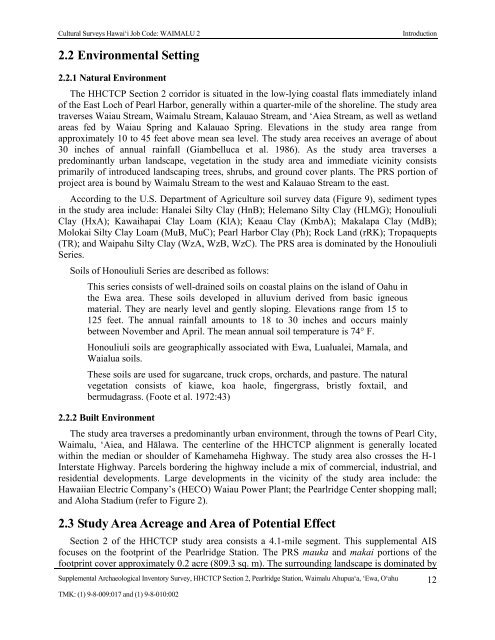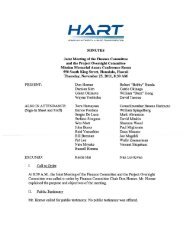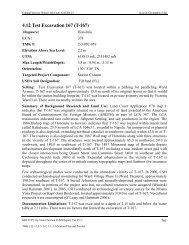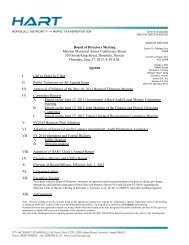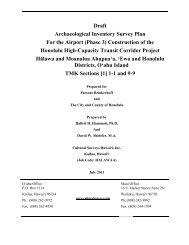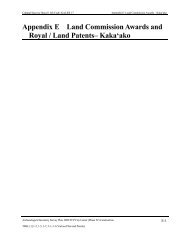Draft Supplemental AIS Report Kamehameha Highway Guideway
Draft Supplemental AIS Report Kamehameha Highway Guideway
Draft Supplemental AIS Report Kamehameha Highway Guideway
Create successful ePaper yourself
Turn your PDF publications into a flip-book with our unique Google optimized e-Paper software.
Cultural Surveys Hawai‘i Job Code: WAIMALU 2<br />
Introduction<br />
2.2 Environmental Setting<br />
2.2.1 Natural Environment<br />
The HHCTCP Section 2 corridor is situated in the low-lying coastal flats immediately inland<br />
of the East Loch of Pearl Harbor, generally within a quarter-mile of the shoreline. The study area<br />
traverses Waiau Stream, Waimalu Stream, Kalauao Stream, and ‘Aiea Stream, as well as wetland<br />
areas fed by Waiau Spring and Kalauao Spring. Elevations in the study area range from<br />
approximately 10 to 45 feet above mean sea level. The study area receives an average of about<br />
30 inches of annual rainfall (Giambelluca et al. 1986). As the study area traverses a<br />
predominantly urban landscape, vegetation in the study area and immediate vicinity consists<br />
primarily of introduced landscaping trees, shrubs, and ground cover plants. The PRS portion of<br />
project area is bound by Waimalu Stream to the west and Kalauao Stream to the east.<br />
According to the U.S. Department of Agriculture soil survey data (Figure 9), sediment types<br />
in the study area include: Hanalei Silty Clay (HnB); Helemano Silty Clay (HLMG); Honouliuli<br />
Clay (HxA); Kawaihapai Clay Loam (KlA); Keaau Clay (KmbA); Makalapa Clay (MdB);<br />
Molokai Silty Clay Loam (MuB, MuC); Pearl Harbor Clay (Ph); Rock Land (rRK); Tropaquepts<br />
(TR); and Waipahu Silty Clay (WzA, WzB, WzC). The PRS area is dominated by the Honouliuli<br />
Series.<br />
Soils of Honouliuli Series are described as follows:<br />
This series consists of well-drained soils on coastal plains on the island of Oahu in<br />
the Ewa area. These soils developed in alluvium derived from basic igneous<br />
material. They are nearly level and gently sloping. Elevations range from 15 to<br />
125 feet. The annual rainfall amounts to 18 to 30 inches and occurs mainly<br />
between November and April. The mean annual soil temperature is 74° F.<br />
Honouliuli soils are geographically associated with Ewa, Lualualei, Mamala, and<br />
Waialua soils.<br />
These soils are used for sugarcane, truck crops, orchards, and pasture. The natural<br />
vegetation consists of kiawe, koa haole, fingergrass, bristly foxtail, and<br />
bermudagrass. (Foote et al. 1972:43)<br />
2.2.2 Built Environment<br />
The study area traverses a predominantly urban environment, through the towns of Pearl City,<br />
Waimalu, ‘Aiea, and Hālawa. The centerline of the HHCTCP alignment is generally located<br />
within the median or shoulder of <strong>Kamehameha</strong> <strong>Highway</strong>. The study area also crosses the H-1<br />
Interstate <strong>Highway</strong>. Parcels bordering the highway include a mix of commercial, industrial, and<br />
residential developments. Large developments in the vicinity of the study area include: the<br />
Hawaiian Electric Company’s (HECO) Waiau Power Plant; the Pearlridge Center shopping mall;<br />
and Aloha Stadium (refer to Figure 2).<br />
2.3 Study Area Acreage and Area of Potential Effect<br />
Section 2 of the HHCTCP study area consists a 4.1-mile segment. This supplemental <strong>AIS</strong><br />
focuses on the footprint of the Pearlridge Station. The PRS mauka and makai portions of the<br />
footprint cover approximately 0.2 acre (809.3 sq. m). The surrounding landscape is dominated by<br />
<strong>Supplemental</strong> Archaeological Inventory Survey, HHCTCP Section 2, Pearlridge Station, Waimalu Ahupua‘a, ‘Ewa, O‘ahu 12<br />
TMK: (1) 9-8-009:017 and (1) 9-8-010:002


